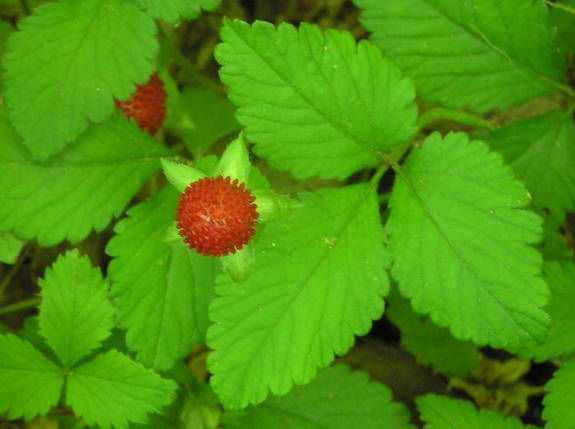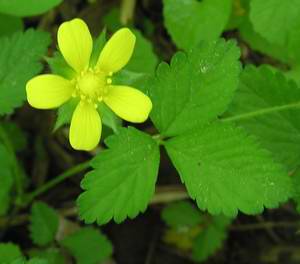|
Return to Hiker's Notebook Home Page
Common Name: Indian Strawberry, False Strawberry, Mock Strawberry, She Mei (Chinese meaning Snake Strawberry) - The small, red fruit has the same general appearance as the more palatable strawberry; it is distinguished by the adjectival Indian to denote its Asian provenance and not due to any association with the Native American "Indians."
Scientific Name: Duchesnea indica - Antoine Nicholas Duchesne, the eponymous source for the generic name, was a noted French botanist (1747-1827) who is credited with explaining the hybridization of the strawberry. He postulated that the large Chilean strawberry, Fragaria chiloensis, that had been brought to Europe by the French military spy Am�d�e Fran�ois Fr�zier would not fruit because the plants were all female; he noted that fecundity was restored by using the male pollen from other strawberry species. Indica is a Latinized rendering of the word "Indian," again in reference to Asian origin. Also listed as Potentilla indica and Fragaria indica.
Indian strawberries are classed as introduced by the USDA and are considered noxious, invasive weeds in many references. They are native to the temperate Asian region that extends from northern Afghanistan across the Himalayas to China and Japan and to the tropical Asian region of India and Southeast Asia. They are, however, widely naturalized in North America and considered by some to be somewhat benign as a ground cover. They have the necessary attributes in that they are fast growing, efficient in propagation, perennially evergreen; A pleasant yellow efflorescence culminates on fertilization into a delicious-looking, red, strawberry-like fruit. They are considered by others as very annoying, primarily due to their profligate growth characteristics.
The efficiency of the Indian Strawberry in naturalization to new regions and habitats is due to a number of factors. The flowers are perfect, or hermaphroditic in that they have both male and female organs on the same flower; the plant is monoecious. While this promotes self pollination it is generally inimical to genetic diversity in that it can lead to a monoculture that is not resilient to changing environmental conditions. It extends its reach by stolons, which are slender, underground stems that form buds at periodic nodes from which new growth erupts and which extend adventitious (occurring at an abnormal place or time) roots to extend the reach of nutrient enrichment.
The phylogeny of the Rosoideae (Rose Family) has been subject to the
reorganization that recent genetic analysis capability has invoked on the
appearance-based
The Indian strawberry fruit is edible, but not palatable. Though its taste is sometimes compared to watermelon, this is a strained metaphor. The Indian strawberry has 3.4 percent sugar 1.5 percent protein and has about 60 milligrams of Vitamin C in a liter of juice. For comparison, a regular strawberry has about 6 percent sugar with ten times as much vitamin C. Like the strawberry, the Indian strawberry is not technically a berry, but an accessory fruit, The achenes are the true fruits - each has a style, a stigma and an ovule. The achenes are embedded in a the hypanthium, a cup-like structure at the base of the flower - it is the growth of the fleshy hypanthium that forms the "fruit." The seeds from the achene (red in the case of Indian strawberry) are embedded in it. The leaves are also edible as a potherb - cooking is recommended. Many herbal compendia include the Indian strawberry as a medicinal plant, probably from association with Asian applications. As is often the case, every part of the plant, and sometimes the plant as a whole, is prescribed as a treatment for a different malady, in this case ranging from an anticoagulant blood thinner to a febrifuge for lowering the high temperatures of a fever. A decoction of the leaves is called out for the treatment of edema, or swelling and a poultice made from the leaves can be used as a vulnerary in the treatment of wounds, boils, burns and abscesses. Even the fruit is singled out for its restorative properties, serving as a cure for various skin diseases. |

 taxonomy
established by Linnaeus in the 18th Century. Potentilla is
a genus of the Rose family with some 500 species of herbs that are mostly
found in the Northern Hemisphere. It has been shown that both the wild
strawberries (formerly Fragaria) and the Indian strawberries (formerly
Duchesnea) are actually all part of the larger Potentilla. The
genetic commonality is consistent with the widespread hybridization of
strawberries of various species. The yellow five-petal flower with the
alternate divided leaves is often mistaken for the cinquefoil, another common
wildflower of the Potentilla genus.
taxonomy
established by Linnaeus in the 18th Century. Potentilla is
a genus of the Rose family with some 500 species of herbs that are mostly
found in the Northern Hemisphere. It has been shown that both the wild
strawberries (formerly Fragaria) and the Indian strawberries (formerly
Duchesnea) are actually all part of the larger Potentilla. The
genetic commonality is consistent with the widespread hybridization of
strawberries of various species. The yellow five-petal flower with the
alternate divided leaves is often mistaken for the cinquefoil, another common
wildflower of the Potentilla genus.